L.E. Carmichael's Blog
November 14, 2025
Goose Barnacle Geese: Folklore in Early Science
I collect information the way crows collect shiny things! Historically, this impulse to collect the weird and wonderful found expression in cabinets of curiosities: precursors of modern museums assembled by aristocrats, explorers, and early scientists. While I acknowledge the devastating context of colonialism* in which these cabinets were assembled, I share the deep sense of awe and wonder that motivated their creators. And so:
Welcome to my own cabinet of curiosities—facts, quotes, and oddments about pretty much everything!
Here’s a fun thing I just learned: barnacle geese are so named because Medieval scholars believed they hatched from… goose barnacles! The Smithsonian Environmental Research Centre has a great article exploring the origins of this notion, which was actually pretty reasonable given the information available at the time. Click on through for the fascinating details!
And thanks to children’s science writer Rochelle Strauss for the tip.
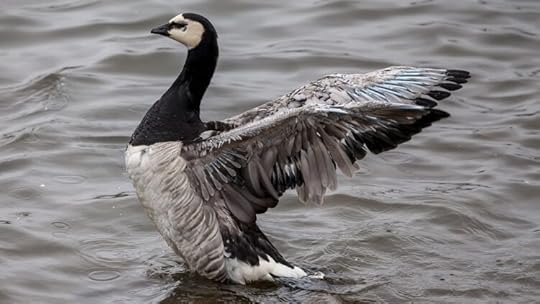
Photo courtesy of Andreas Wieth, via Wikimedia Commons.
* For more info on historical cabinets of curiosities, check out these articles:
Smithsonian Mag: How Cabinets of Curiosities Laid the Foundation for Modern Museums
Sotheby’s Institute of Art: Cabinets of Curiosities and the Origin of Collecting
Art & Object: The Cabinet of Curiosities & Colonialism
https://www.artandobject.com/news/cabinet-curiosities-colonialism
November 1, 2025
A. T. Balsara: Why Rats? Writing the Unconventional in YA Fiction
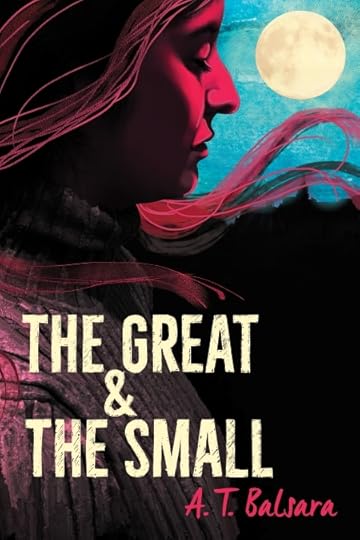
“A poignant and timely rumination on power, resistance, and compassion.” – Kirkus Reviews
Welcome to Cantastic Authorpalooza, featuring posts by and about great Canadian children’s book creators! Today’s guest: A. T. Balsara . Take it away, Andrea!
“Why rats?”
The man’s voice was thick with scorn, like he’d just stepped in something disgusting. It was 2017, and the first edition of my young adult novel, The Great & the Small, had just come out. Using dual narratives, the story follows a rat colony and a teenage girl as a plague war, started by rats, rages through the world, exploring the rise of authoritarianism, prejudice, and the cost of blind obedience. I’d just finished giving a presentation on my book to a local writer’s group and was gathering my notes when his question cut through me. It was just him and me left in the room. “Why rats?” he asked again, with a snorting laugh.
I wish I could say I responded with something witty or profound. Instead, I froze. Mumbling something vague about how rats are cool, I escaped to my car to have a good cry and think of all the things I should have said. It was my first hint that not everyone shares my love for the unconventional.
With the second edition of the book (released Fall 2024), I expanded the teenage protagonist Ananda’s arc—exploring themes of buried trauma, the reverberations of sexual abuse, and linking the search for truth not only outwardly, but inward as well. Even so, that same dratted question hung over my head like the sword of Damocles:
Why rats?
While I’m not shocked by the question anymore, it’s still a hard one to answer, because as a writer, I can’t fathom not being fascinated by stories about rats. My love of animal protagonists was born when I read Watership Down, by Richard Adams, about a warren of rabbits determined to find freedom and a new home. The world-building was so brilliant, so satisfying, that by the end, I felt like I’d glimpsed life as a rabbit. My world had expanded, and my perspective forever changed. With The Great & the Small, I wanted to do the same thing.
But why—specifically—rats?

Ananda saves Fin
First, rats are extremely cool. They can leap four feet in the air, chew through concrete, and navigate in pitch darkness by using their whiskers as a sophisticated sensory array of antennae as nimbly as ninjas wearing night-vision goggles. And while wild rats can take down a house cat, domesticated rats are affectionate sweethearts. In researching the book, I got a little dumbo rat who became my guide through this new world. Frodo would perch on my shoulder and give me tiny kisses on my cheek that conquered my heart. His depth of personality and intelligence surprised me, and his spirit echoes through the main rat character, Fin.
But it’s not all sweetness and light. In the mid-1300s, the bubonic plague hit Europe with such virulence that it wiped out up to half of the continent’s population within a few years. Rats were the plague vectors, carrying infected fleas. When I read about the rat’s role in an event that reshaped society—the repercussions of which we still feel today—I had a realization: if rats could organize, they could wipe out humanity. Armed with the plague, they would be unstoppable. Almost.
For years, I’d been trying to think of a story about the cost of blind obedience, sparked by a visit to the concentration camp museum in Dachau, Germany, with my family when I was 10. Needing to understand what caused one person to grow into a Hitler or a Stalin, and another person into a Martin Luther King or Nelson Mandela, writing was my way of untangling what I had seen and the deep confusion I’d felt growing up. As someone who had also experienced deep, buried trauma and undiagnosed PTSD from age five—recovering my memories in my early 20s—my need to understand the nature of good and evil bordered on obsession. Now, I finally had my story, with rats as the perfect foils.
Set in modern day, the rat colony is ruled by the Stalin-like “Beloved Chairman.” At first, the Beloved Chairman’s nephew, Fin, is a true believer and loyal enforcer in the colony’s plague war against humans. But when Fin is saved by Ananda—a teenage girl haunted by a trauma she can’t remember—it sets a chain of events into motion. As Fin sees cracks in the world he once trusted and Ananda searches for the truth buried in her past, their stories unfold in parallel, exploring how trauma shapes us, how dictatorships rise, and what it takes to find light in the darkness.
As for the man who, at a writer’s meeting, no less, scorned my choice of characters? Although it hurt, his comment helped me realize this: writing isn’t about pleasing the crowd. It’s about truth. It’s about letting the stories only we can tell come to life and sending them into the world to find their way. And now, as we face censorship, book banning, and pressures from all sides to conform to a particular narrative, our commitment to tell the truth through our stories matters more than ever.
With unconventional characters, readers must look closer and try harder to understand, but the rewards are original stories that stay with them and change their view of the world.
For writers, unconventional characters add layers of richness, depth, and detail, drawing readers deeply into our created worlds.
And while there will be doubters and the occasional scoff, there will be readers who dive in, feeling their own worlds expand alongside ours.
Why rats? Why not rats?
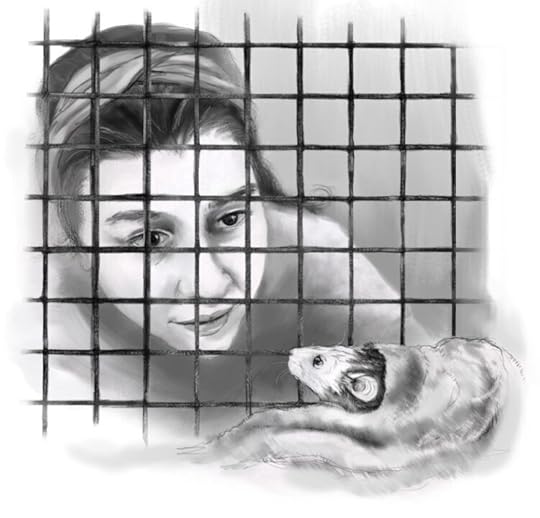
Ananda nurses Fin back to health
Andrea Torrey Balsara is an award-winning children’s and young adult author-illustrator, motivational speaker, and certified energy medicine practitioner. She is passionate about reframing life and art through the lens of “The Hero’s Journey.” Andrea writes and illustrates for young children under her full name, Andrea Torrey Balsara, and for young adults under A.T. Balsara.
She is available for motivational speaking, classroom and online presentations, book readings, one-on-one coaching, and podcasts.
Connect with Andrea at:
Instagram: https://www.instagram.com/andreatorreybalsara/
Facebook: https://www.facebook.com/AndreaTorreyBalsaraAuthorIllustrator/
Bluesky: https://bsky.app/profile/torreybalsara.bsky.social
October 17, 2025
Pride and Prejudice and Mantis Shrimps
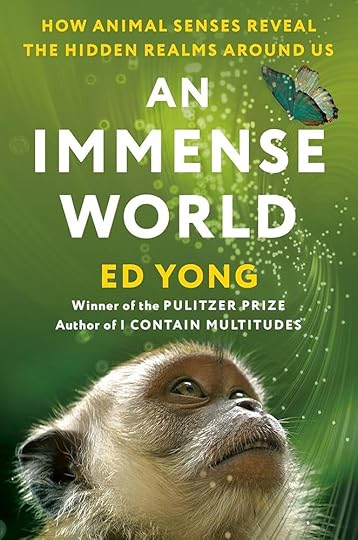 I collect information the way crows collect shiny things! Historically, this impulse to collect the weird and wonderful found expression in cabinets of curiosities: precursors of modern museums assembled by aristocrats, explorers, and early scientists. While I acknowledge the devastating context of colonialism* in which these cabinets were assembled, I share the deep sense of awe and wonder that motivated their creators. And so:
I collect information the way crows collect shiny things! Historically, this impulse to collect the weird and wonderful found expression in cabinets of curiosities: precursors of modern museums assembled by aristocrats, explorers, and early scientists. While I acknowledge the devastating context of colonialism* in which these cabinets were assembled, I share the deep sense of awe and wonder that motivated their creators. And so:
Welcome to my own cabinet of curiosities—facts, quotes, and oddments about pretty much everything!
If you’re an adult fan of my science books for kids, there’s a good chance you enjoy reading science books written for adults, too. Ed Yong’s An Immense World is one of the best science books I’ve ever read – well-organized, clearly-written, and overflowing with mind-blowing facts. I’m an actual animal expert, and I learned something new on every single page.
The thing I enjoyed most however, is Yong’s sense of humour. I’ll share just two examples:
Imagine you are a mantis shrimp. It is a truth universally acknowledged that you are in want of something to punch.
Bonus points for the Pride and Prejudice reference, Mr. Yong! I had barely finished giggling when he followed up with this, perhaps my favourite line in the whole book:
Mantis shrimps throw punches like humans throw opinions—frequently, aggressively, and without provocation.
Highly recommended to adults and science-loving teenagers. It would also be an incredible resource for sci-fi or fantasy writers looking to develop their own non-human life forms.
* For more info on historical cabinets of curiosities, check out these articles:
Smithsonian Mag: How Cabinets of Curiosities Laid the Foundation for Modern Museums
Sotheby’s Institute of Art: Cabinets of Curiosities and the Origin of Collecting
Art & Object: The Cabinet of Curiosities & Colonialism
https://www.artandobject.com/news/cabinet-curiosities-colonialism
October 4, 2025
Stephanie Ellen Sy: Beyond the Stripes – Why I Wrote You Can’t Tame a Tiger
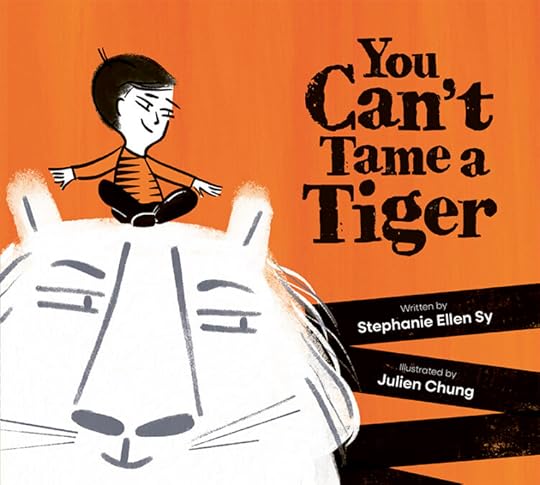 Welcome to Cantastic Authorpalooza, featuring posts by and about great Canadian children’s book creators! Today’s guest:
Stephanie Ellen Sy
. Take it away, Stephanie!
Welcome to Cantastic Authorpalooza, featuring posts by and about great Canadian children’s book creators! Today’s guest:
Stephanie Ellen Sy
. Take it away, Stephanie!
When my pandemic writing group challenged me to try fiction—specifically a children’s story—I knew exactly which question to explore, one formed by my own childhood: Who gets to decide what you are?
Growing up in Hong Kong’s international community, we were all “mutts,” in the best sense—constantly absorbing languages and traditions from one another, so that multiple passports and mixed identities weren’t remarkable. They were simply the norm. It was only later that I encountered a world obsessed with “neat, tidy boxes,” and saw how that pressure could weigh on a child. I wanted to write a story that would give children the courage to simply be themselves. That’s how You Can’t Tame a Tiger was born.
The book introduces a boy and his best friend, Imran, who is a tiger. There’s just one thing: Imran isn’t orange, and he has no stripes. This confounds the boy. How can his friend be a tiger if he doesn’t look like one?
So, the boy takes matters into his own hands. His first attempts are about finding any label for his friend. He draws zigzag stripes, hoping people will see a zebra. He paints polka dots, aiming for a cheetah. Each time, Imran corrects him with patient, if bemused, logic: “I don’t eat grass,” and “Tigers run when they feel like it.” His refrain, “You can’t tame a tiger,” is a gentle warning.
But the boy’s final attempt is the most direct. He takes a brush and tries to paint Imran orange, insisting, “I’m turning you into a tiger.” This is the ultimate act of “fixing,” and it’s the final straw. Imran doesn’t just correct him this time; he says “No,” and with a magnificent tiger-leap and a cannonball into a pool, he actively washes the paint away. He will not be painted into someone else’s idea of what he should be. The boy’s anxiety finally melts away only when Imran’s authentic roar convinces the other children. In that moment, the boy finally understands: his friend never needed fixing. The problem was his own fear that the world wouldn’t understand something unique. Imran’s lesson is simple but profound—true friendship means recognizing that the most magnificent thing about someone is the very thing you can’t tame.
That is the invitation at the heart of You Can’t Tame a Tiger: To find the courage to let those we love exist authentically. It’s a reminder that being truly seen for who you are is a gift we all deserve.
Especially tigers without stripes.
September 19, 2025
Your Kid Lit Guide for This Year’s Book Flood
The keeners among you might already be thinking about the year’s best holiday, Iceland’s Jólabókaflóðið, or Book Flood. If you’ve got young readers on your giving list, I got you. I started my MFA in Writing for Children and Young Adults in January, and I’ve already read more than 130 books this year. If you want the whole list, you can follow me on Storygraph. If not, here are some standout favourites to make your holiday gift giving a little easier.
(No links provided – please support your local indie bookstore if you can!
If you can’t, copy and paste the title into the online retailer of your choice.)
Picture Books
Knuffle Bunny: A Cautionary Tale by Mo Willems (Hyperion, 2004)
When Trixie accidentally leaves her beloved stuffed animal at the laundromat, she tries desperately to explain the problem. Because Trixie is pre-verbal, Williams reveals her character through her actions: babbling, crying, going boneless, and finally throwing a full-on tantrum. Because the story is told through Trixie’s point of view, the reader understands that this “bad” behaviour is an attempt to communicate with adults who just don’t get it. Funny, relatable, and so very full of emotion, this book is an excellent example of a child-sized crisis that must be solved.
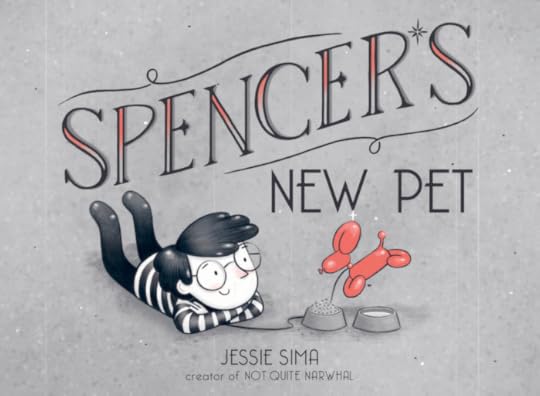 Nell Plants a Tree by Anne Wynter, illustrated by Daniel Miyares (Balzer + Bray, 2023)
Nell Plants a Tree by Anne Wynter, illustrated by Daniel Miyares (Balzer + Bray, 2023)
A girl plants a tree that her grandchildren later climb. Each composite “scene” plays out over two time periods: the past, in which Nell takes one step toward planting a tree, and the present, in which the tree plays a central role in her family’s lives. But each scene begins in the present, looping back to the “Before” which makes the present-day actions possible. This circularity in each “scene” reinforces the circularity of the story arc as a whole: in the final spread, Nell and her grandchild plant a new tree. A gorgeous and powerful reminder that life itself is circular and intertwined.
Spencer’s New Pet by Jessie Sima (Simon & Schuster, 2019)
A wordless picture book in which Spencer becomes deeply attached to a balloon animal dog, feeding it, playing with it, bathing it, and protecting it from all the sharp things that might puncture it! When the wind blow the balloon dog away, he pursues it past many hazards, ultimately catching it just in time for a game of pin the tail on the donkey. Over many spreads, Sima creates and reinforces a particular understanding of the story world, only to subvert expectations in the most delightful way. I also loved the illustrations that show Spencer reading Pygmalion—a Greek myth about a sculptor who falls in love with his own creation, which the gods bring to life. While the story works perfectly without that context, it adds a little extra sparkle for adult readers who recognize the reference!
Nonfiction
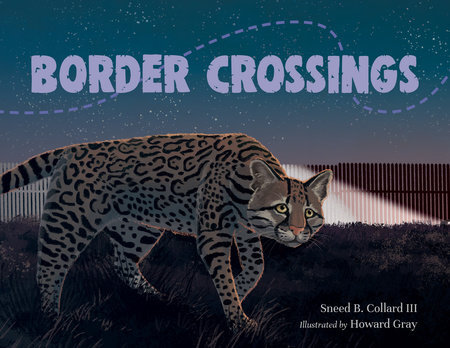 Border Crossings, by Sneed B. Collard III, illustrated by Howard Gray (Charlesbridge, 2023)
Border Crossings, by Sneed B. Collard III, illustrated by Howard Gray (Charlesbridge, 2023)
Picture book about the impact of border walls on wildlife. An ocelot in Texas heads south, but can’t cross the wall dividing the USA and Mexico; a female heading north finds her path unobstructed, successfully crossing into Arizona. These cats provide framing and context for information about the ecology of the border zone and the impacts of man-made structures on wildlife. Collard adds drama by depicting the male ocelot as a character with a clear goal: to find a mate and a territory of his own. Sensory and specific details provide a cat’s-eye view of the border wall; when adaptations and behavioural strategies for overcoming natural challenges fail in the face of artificial threats, the reader feels the impact of that failure and its potentially devastating consequences. Back matter includes an author’s note expanding on the importance of border habitats (e.g. diversity and endangered species) and explains that walls can be bad for humans, too. A glossary and reading list support young readers who may be inspired to become activists. Winner of the 2023 NCTE Orbis Pictus Award (the year that Polar received an Honor!)
Honeybee Rescue: A Backyard Drama, by Loree Griffin Burns (Charlesbridge, 2022)
Picture Book about rescuing honeybees who’d built a hive in a location that put their survival at risk. I love the hybrid structure of this book: it’s a narrative, with expository spreads that provide more context and detail on bee biology and bee rescue equipment. The narrative provides tension and suspense, with more technical information (in expository spreads) offered only when needed. The information about the bee vacuum was fascinating and hilarious, and incredible photographs throughout help kids visualize the action. Back matter includes the usual glossary, author’s note, sources and readings, but also an interview with the bee rescuer, which added further depth and broader context. This interview also tells kids what to do if they encounter bees in need of rescue (I’m sending a copy of this one to a friend who has staged two much-less-professional rescues of swarms from her own backyard beehives).
Middle Grade
Inside out & Back Again, by Thanhha Lai (Harper, 2011)
Novel in verse about Hà, a young refugee, and her family who evacuate from Vietnam and start a new life in Alabama, where Hà encounters anti-Vietnamese racism and struggles with feeling stupid (and being treated as stupid) at her new English-speaking school. The text is spare to the point of gauntness, but powerful imagery brings each poem to life. I was particularly struck by Lai’s use of foods and flavours to signal Hà’s emotions; stark contrasts between delicious foods she grew up with and disgusting foods encountered at sea and in the USA capture the disorientation and alienation of being in places where everything (even the sound horses make) is different. I was also struck by how deeply Lai depicts supporting characters, despite her 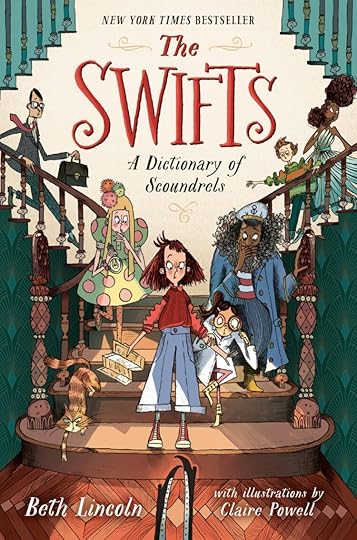 minuscule word count—also attesting to the power of carefully chosen details.
minuscule word count—also attesting to the power of carefully chosen details.
Turtle in Paradise, by Jennifer Holm (Yearling, 2010)
Historical fiction about a girl sent to live with relatives in Key West during the Great Depression. Details like weird nicknames, new foods, and the fact that Turtle is the only kid who wears shoes not only bring the location and culture of Key West to life, but help establish Turtle’s sense of dislocation and isolation in her new surroundings. Towards the end of the book, Turtle realizes she’s also gotten used to not wearing shoes: a subtle and beautiful way of showing readers that this sassy-but-charming heroine has found a new home. Throw in rumrunners, a Hemingway cameo and some buried pirate treasure, and I was genuinely disappointed to reach the end!
The Swifts: A Dictionary of Scoundrels, by Beth Lincoln (Dutton, 2023)
I loved this book SO MUCH that I read it twice and then wrote an essay for VCFA about the character arc of the protagonist, Shenanigan Swift. It’s a cozy gothic middle grade murder mystery, and it is flat out awesome! I can’t wait to read the sequel.
Young Adult
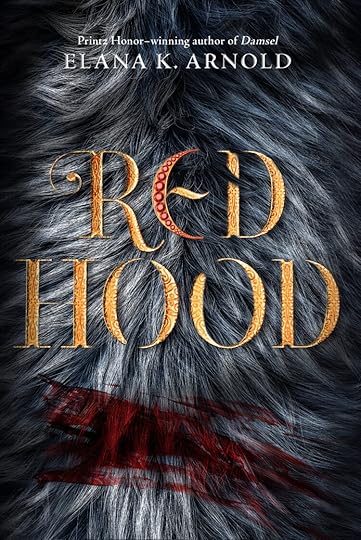 Red Hood, by Elana K. Arnold (Balzer + Bray, 2020)
Red Hood, by Elana K. Arnold (Balzer + Bray, 2020)
A retelling of “Little Red Riding Hood,” in which predatory men and boys are literal werewolves and the protagonist, Bisou (whose name is French for “kiss” but also plays on the medieval French word for werewolf: bzou), gains supernatural abilities to hunt them while menstruating. A brilliant example of how to modernize a fairy tale while maintaining the archetypal resonance and threatening undercurrents of the source material, Red Hood manages to feel both timeless and very much of the present moment. It’s also the most effective use of second person I’ve ever encountered: Bisou is her own person, but also every person who is reading her story, underscoring the universality of the threat that she and all women face every day. At the end of the book, Bisou’s “you” becomes the “we” of the girls who are now standing beside her, helping making the point that women in the real world are also stronger in packs than working alone. Love, love, love!
The Brides of Rollrock Island, by Margo Lanagan (Ember, 2012)
Fantasy inspired by selkie stories, set on an island where (for a while) every bride is a seal-woman. Rollrock Island is a place out of time, both haunting and treacherous, where the boys of the settlement gather “sea hearts” for their mothers’ dinners while “the old witch” knits them blankets out of seaweed. Lanaghan’s gorgeous writing provides an unsettling counterpoint to her subject matter, which explores envy, dark desire, and issues of exploitation and consent.
What about you? What favourite reads are you bursting to share? Drop them in the comments!
September 6, 2025
Karen Krossing: What Does Your Street Remember?
Welcome to Cantastic Authorpalooza, featuring posts by and about great Canadian children’s book creators! Today’s guest: Karen Krossing . Take it away, Karen!
Please take a moment to place both your feet flat on the floor. Can you feel the floor beneath your feet? The building you’re in? The land that lies beneath us all?
You are here. In this place. On this land. Many feet have walked here before you, and many will walk this place in the future.
My inspiration for writing My Street Remembers was simply “place.” I wanted to explore our collective history of place over a vast period. I wanted to peel back the history of one city street in North America—from 14,000 years ago to the modern day—to reveal the collective story of the land on which we live.
This narrative nonfiction picture book is a collaboration between me—an author of White settler descent—and Anishinaabe artist Cathie Jamieson. It tells the story of one street’s development from the Ice Age to the present day, with a focus on Indigenous Peoples, the effects of colonialism, and a healing path toward a community of the future. It asks young readers: What does your street remember?
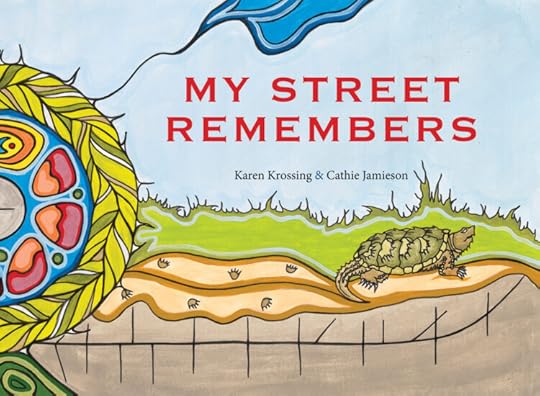
Why I Wrote This Book
Writing this book was a journey in understanding where I live.
I began writing with an awareness of my heritage as a White settler of this land. From family stories, I knew my ancestors came from Scotland hundreds of years ago. I also knew they benefitted from treaties and laws that harmed Indigenous Peoples, and I’ve had advantages because of my ancestry. It was an uncomfortable place to write from.
Researching, writing, and collaborating on this book was an act of reconciliation for me. A way to reach out a hand to Indigenous Peoples as traditional inhabitants of this land and community partners of yesterday, today, and tomorrow. It was also a journey of deepening my relationship with place and my collective community.
What Does Your Street Remember?
This book invites readers of all ages to deepen their relationship with the land beneath their feet. Wherever you are, you can ask: What stories does your street hold? Below are some ideas for how you might answer that question.
Notice Your Street: Spend some time noticing the street where you live. What do you see and hear on your street? Who walks there now? What do you know about those who have walked it before?
Notice Your Relationship with Belonging: Consider your connection to your street. What do you love about it? Do you feel like you belong? What would help you feel like you belong?
Notice the Illustrations in My Street Remembers: Cathie Jamieson created rich, detailed illustrations about how one place has changed over 14,000 years. When you’re reading, what do you notice about who has lived on this street over time, the changing tools and technology, the changing plants and animals, and the changing homes and other buildings?
Find Out More About This Street: After you read this book, ask yourself: What have you learned about how this one street has changed over time? Look at the information in the back of the book to learn more about the history of this street.
Explore Your Street: What can you learn about your street? Use resources such as Native-Land.ca and Whose Land to learn more about the land where you live.
Consider Collective Relationships: What does it mean to be a good friend? What does the word promise mean? The word treaty refers to a promise made between two groups of people. Anyone who lives in what is now North America is a treaty partner. Treaties uphold Indigenous rights to land, water, education, health care, and more. Traditional Territory refers to an area where Indigenous Peoples have lived and continue to live, and Treaty Land refers to an area with specific agreements between Indigenous Peoples and settler governments. What do you know about the treaties and territories that affect your street?
Discuss Land Acknowledgements: Listen to your school’s land acknowledgement. What is the purpose of it? What does it mean to you? How do you think your school could improve it?
Explore Reconciliation: What does reconciliation mean to you? What are ways you can connect and reconcile with the place where you live? For example:
Reach out to honour and connect with those who live on your street now or who have lived there in the past.
Consider how you will share this land where you live with those who will walk it in the future. How will you care for this land? How can we help everyone to belong?
The Canadian government committed to 94 calls to action in 2015 to redress the legacy of residential schools and advance reconciliation. Explore Indigenous Watchdog, which reports on the number of calls to action that are in progress, stalled, not started, or completed.
Gratitude Walk: Go for a walk on your street. Notice what you see, hear, feel, and smell. Notice the objects, creatures, plants, and connections between them. Notice your body’s responses to the place you’re walking through. What do you feel connected to? What do you feel grateful for? Write your observations or share them with a friend.
Remembering Walk: Bring a notebook on a walk on your street. What memories arise? Write about your memories—images, sensory details, feelings, and so on.
Poetry Prompt: Use the notes from your gratitude walk or remembering walk to write a poem. First, circle words from your notes that feel meaningful to you. Then play with those words to write your poem. If it feels right, make connections between you, your body, and the place where you live.
The land that became our streets settles on us as we settle on it. When we deepen our relationship with place, we understand ourselves—and others—better.
You can learn more about Karen Krossing and her books by visiting karenkrossing.com.
August 22, 2025
The Witch Lore of Newfoundland
I collect information the way crows collect shiny things! Historically, this impulse to collect the weird and wonderful found expression in cabinets of curiosities: precursors of modern museums assembled by aristocrats, explorers, and early scientists. While I acknowledge the devastating context of colonialism* in which these cabinets were assembled, I share the deep sense of awe and wonder that motivated their creators. And so:
Welcome to my own cabinet of curiosities—facts, quotes, and oddments about pretty much everything!
I’m in Newfoundland right now, spotting wildlife and soaking up the justifiably-famous scenery. But did you know that Newfoundland’s Memorial University also has the best folklore department in Canada? It’s true – and here’s a snippet from Dr. Barbara Reiti’s fascinating book on Newfoundland’s witch lore:
And ‘wishing’ is, after all, not so different from praying, especially when intensity is related to outcome. All the religions taught the efficacy of prayer, and that is perhaps their greatest collective contribution to witch lore. For if a person can pray hard enough to ‘get an answer’ – that is, a result – then maybe he or she could will other things to happen as well; at least it must have occurred to some people to try a secular version of moving whatever invisible powers that might be.

* For more info on historical cabinets of curiosities, check out these articles:
Smithsonian Mag: How Cabinets of Curiosities Laid the Foundation for Modern Museums
Sotheby’s Institute of Art: Cabinets of Curiosities and the Origin of Collecting
Art & Object: The Cabinet of Curiosities & Colonialism
https://www.artandobject.com/news/cabinet-curiosities-colonialism
August 2, 2025
Stephanie Gibeault and The Dog Who Saved the Bees
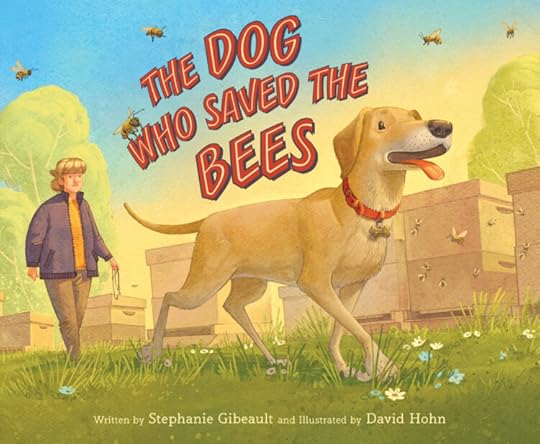 Welcome to Cantastic Authorpalooza, featuring posts by and about great Canadian children’s book creators! Today’s guest:
Stephanie Gibeault
. Take it away, Stephanie!
Welcome to Cantastic Authorpalooza, featuring posts by and about great Canadian children’s book creators! Today’s guest:
Stephanie Gibeault
. Take it away, Stephanie!
Like a dog spotting a squirrel, I’m usually the type to be easily distracted by the next new shiny idea. But sometimes I come across a story and it won’t let go. That was the case when I met Cybil Preston and learned about her rescue dog Mack. I interviewed Cybil for an American Kennel Club article seven years ago and only a few months later I wrote the first draft of the manuscript that became my latest picture book The Dog Who Saved the Bees.
As the chief apiary inspector for the Maryland Department of Agriculture, Cybil is responsible for certifying the state’s commercial beehives free of disease before they ship across the United States to pollinate crops like almonds, apples, and strawberries. Without those commercial beehives, we wouldn’t have those foods on our tables. Flatbed trucks carry bee colonies along highways from state to state and farm to farm, and one truck can transport millions of honey bees. But if a diseased colony slips through, it can decimate local bee populations at its new destination.
Back in 2018, the world of commercial pollination was new to me, and I was fascinated. But even more fascinating was the fact that Cybil uses scent detection dogs to find one particular bee disease—American foulbrood. And her first sniffer dog, Mack, was an unruly and untrained Labrador retriever she rescued from a lonely life in a garage. In the beginning, Mack wouldn’t listen and couldn’t focus, but Cybil didn’t give up. Through dedication and hard work, she trained Mack to become the only certified foulbrood detection dog in the United States. Together they even went on to earn the Customer Service Heroes Award from the governor of Maryland. Now I was really hooked.

Mack sniffing for bees infected with foulbrood.
I submitted my article that summer, but Cybil and Mack’s story kept floating around in my head. It had dogs, it had bees, but most of all it had heart. I knew children would love it as much as I did. So, I worked on the manuscript for about four-and-a-half years. At one point, it was even a middle grade book proposal. I took it to my critique partners time and time again (I’m so grateful for their patient feedback) and used every opportunity I could for professional critiques. Just like Cybil wouldn’t give up on Mack, I wouldn’t give up on this story. And I’m so glad I didn’t.
In 2023, senior children’s editor Barb McNally at Sleeping Bear Press saw the value in my manuscript. Once it was paired with David Hohn’s incredible illustrations, The Dog Who Saved the Bees blossomed into something even better than I could have imagined way back in 2018. David captured Cybil and Mack perfectly, and the emotion in his art pulls on the heartstrings. I hope readers fall in love with this story the same way I did and learn to appreciate dogs and bees and all they do for us. But even more, I hope they discover the importance of persistence. Because those dreams that take more time and effort than expected are the most satisfying when you achieve them.
July 14, 2025
Marcus Cutler: Creating Comedic Picture Book Duos
 Welcome to Cantastic Authorpalooza, featuring posts by and about great Canadian children’s book creators! Today’s guest:
Marcus Cutler
. Take it away, Marcus!
Welcome to Cantastic Authorpalooza, featuring posts by and about great Canadian children’s book creators! Today’s guest:
Marcus Cutler
. Take it away, Marcus!
July 7, 2025
Gardening with Gord
I like to joke that my gardening aesthetic is “witchy neglect.” I toss some plants in the ground and wait to see what grows. If it attracts bees, butterflies, or hummingbirds – and the wild bunnies don’t devour it – I plant more of it next year.
This spring, garden witchiness leveled up a bit, with the addition of Gord.
Let’s back up a bit.
Last October, Tech Support came home with a ghost pumpkin. He buys a pumpkin every October, despite the fact that:
we never have time to carve it
my efforts to cook things using pumpkin-not-from-a-can have never turned out well.
The pumpkin sat on the kitchen counter, and a week or so after Halloween, we named him Gord.*
You can’t eat a pumpkin once you’ve named him, so what do you do with him?
Obviously, you invite him to stay for Christmas (and at New Year’s, you give him a pointy hat).
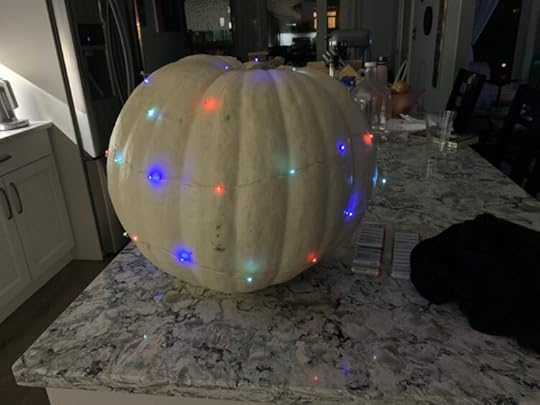
When February rolled around, we discovered that Gord was quite the romantic.
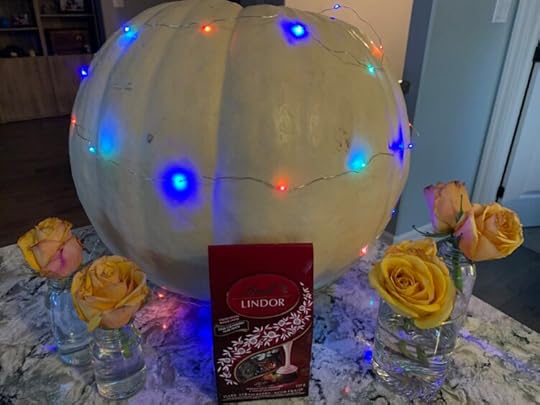
Shortly after St. Patrick’s Day, however, a couple of worrying brown spots appeared on Gord’s bumpy backside. And soon there were the first signs of mold…
All of which meant that Gord couldn’t stay inside anymore. But by this time, he was practically a member of the family, and neither Tech Support nor I felt good about consigning him to the curb. So we put him in the garden instead.

The ice storm did him no favours, and Gord soon folded in on himself, beginning to resemble a donut more than a pumpkin. But that didn’t stop him from making a new friend: one of this spring’s crop of baby bunnies.

Shortly after the photo below was taken, Gord started attracting friends of the wriggly-insect variety, and we knew it was finally time to let him go. The only question was how to lift a semi-liquified gourd out of the garden without getting him all over ourselves. It took teamwork, a jumbo black garbage bag, and our experience pooper-scooping after family dogs, but we managed it.
So long, Gord. Enjoy that big witchy garden in the sky.

Are you a gardener? How would you describe your own approach to making things grow?
*Get it? Gord the Gourd? Not the most sophisticated joke in the universe, I grant you, but it made me laugh.



